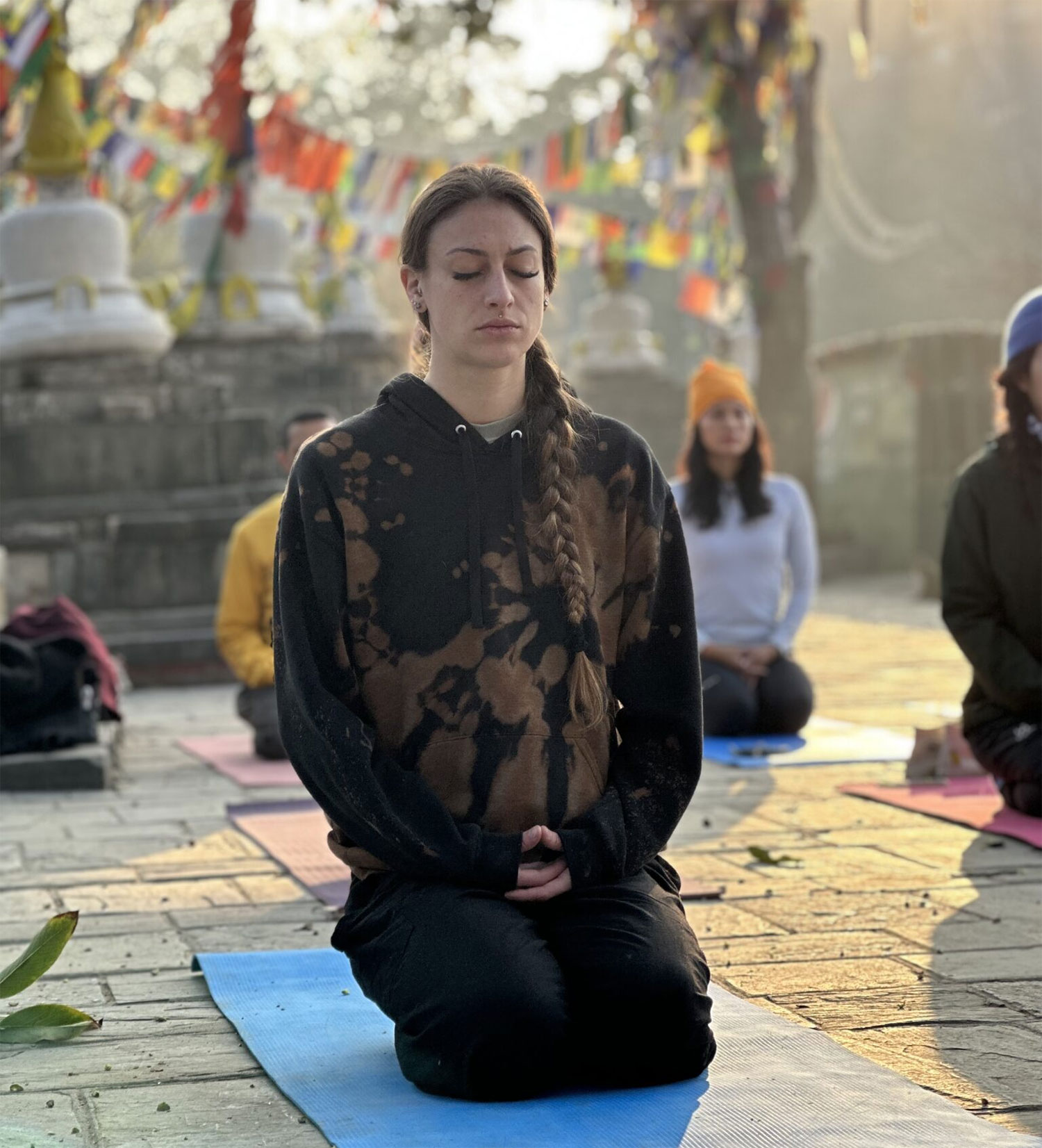
27 Jan 2025 Himalayan Yoga Academy
In the present world, Yoga is an integral part of the lives of human beings. An excellent practice of maintaining physical and mental vitality into old age through the development of flexibility, strength, and clarity of mind. It aids in the proper flow of energy for reducing stress and maintaining well-being. We present the top 7 yoga poses for youthfulness or anti-ageing where one feels re-energized, improves posture, and maintains a vibrant and youthful spirit with regular practices.
Top 7 Yoga Poses for Youthfulness or Anti Ageing
A. Ustrasana (Camel Pose)
Ustrasana, or Camel Pose, is a deep backbend yoga pose. In this pose, a yoga practitioner kneels and curves the back, reaching hands toward the heels. It’s among the 26 asanas in the Bikram Yoga series.
Steps
- Kneel on the mat with your feet flat on the floor, toes pointed backward.
- Hips aligned with knees and the spine softly arched.
- Keep the chest open, head up, and elbows back.
- Slowly place your hands on your heels (or lower back for beginners).
- Look up with a slight backward tilt.
- Keep your neck soft and hold for 10-20 seconds while breathing hard.
- Release by lifting your chest upwards and with the support of your hands, rise to an upright position slowly.
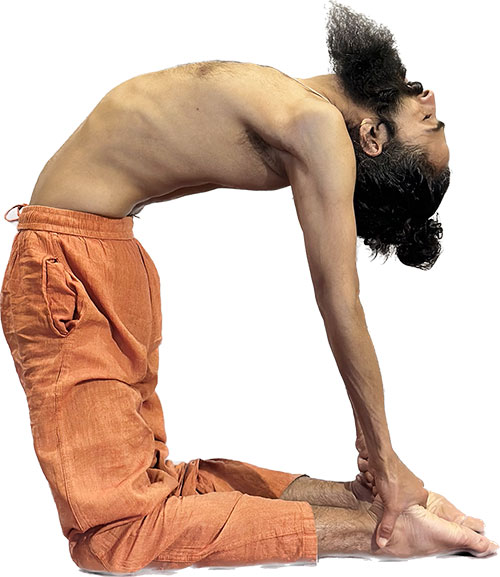
Ustrasana Benefits
- This backbend pose opens up the chest and gives a good stretch to the entire front of the body, which enhances circulation and stretches the stiffness out, promoting a youthful, energetic posture.
- Ustrasana supports detoxification and helps in maintaining weight by improving the metabolic rate.
- It expands the chest and increases lung capacity thus stimulating the health chakra.
- The forward stretch of the body opens up the abdominals, hip flexors, and quadriceps.
- It cures flabby shoulders and correct postures in case of regular practice.
- The organs in the digestive system are stretched which is very helpful for metabolism and digestion.
- It minimizes back problems and makes the spine flexible.
Ustrasana Side Effects
- Improper practice results in injury to the lower back or neck.
- Therefore, this yoga posture is better avoided if one has certain back and neck problems for some time.

B. Tadasana (Mountain Pose)
Tadasana or mountain pose is a basic standing posture that stands straight, with the feet together, and legs straight. The body aligns with hands alongside the body, a wide chest, arched shoulders, and the crown of the head upwards.
Steps
- Stand on a mat with a straight-legged posture, the feet together, heels slightly apart, and wide-set toes.
- Draw your weight evenly into the body and slowly lift your kneecaps.
- Open your chest wide, straighten your spine, and keep your shoulders aligned over your hips.
- Stretch your hands straight up with palms facing forward.
- Tilt the crown of the head upwards without tilting the chin upwards but keeping it parallel to the ground.
- Remain in a steady pose for 15-30 seconds, breathing slowly.
- Bring your hands down and back into a normal standing position.
Tadasana Benefits
- This asana supports a straight posture by giving strength to the core and spine and reduces the ageing signs due to better body mechanics.
- The leg and foot muscles strengthen thereby contributing to better balance and coordination.
- Proper body alignment improves blood circulation and respiration.
- It calms the mind and improves concentration promoting mental focus.
- It increases body awareness and balance and helps efficient movement ultimately promoting weight management.
Tadasana Side Effects
- The improper alignment of hips, feet, or shoulders can cause strain in the lower back or knees.
- Avoid knee locking for those people having knee problems.
C. Chakrasana (Wheel Pose)
Chakrasana, or Wheel Pose is a backbend asana in an advanced form where practitioners lift their body into a full curve. The other name for this asana is Urdhva Dhanurasana.
Steps
- Lie flat on the mat and bend your knees and feet.
- Keep hip-width apart and place your hand and fingers directed toward your shoulders with your elbows bent.
- Lift your hips upward facing with hands and feet pressing into the mat.
- Straighten the arms, and lift the back in an arch.
- Continue pressing the feet and hands down while lifting the chest and head.
- Push back, keeping your aim to get a deep backbend.
- Keep your legs and arms straight with an open chest.
- Keep on inhaling and exhaling throughout while holding for 15-30 seconds.
- Slowly bend the elbows and knees, gently lay your back on the mat, and rest to release.
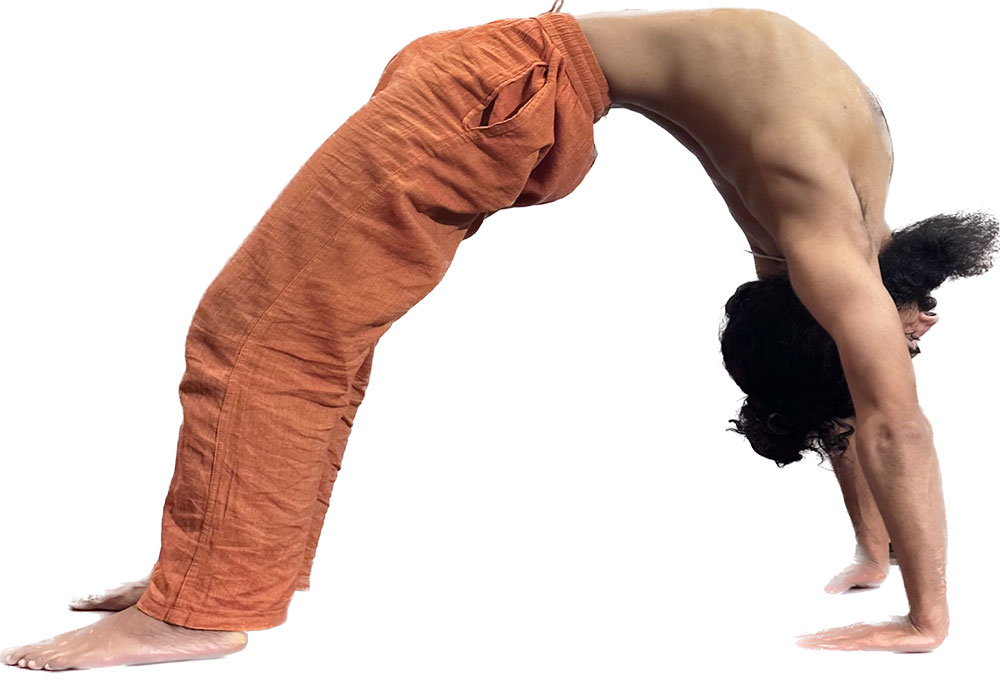
Chakrasana Benefits
- It makes the spine, chest, and shoulders more flexible, hence rejuvenating the nervous system and contributing to a feeling of vitality and youthfulness.
- The core, arms, and legs strengthen and stabilize.
- The breathing progresses with an improvement in chest and lung capacity.
- It activates the nervous system and promotes vitality.
- Regular practice of this pose gives back pain relief.
- Proper blood circulation and muscle strengthening help to burn body fat resulting in weight loss.
Chakrasana Side Effects
- The incorrect practice may cause strain on the lower back or neck.
- Avoid this pose if suffering from spinal problems or any neck problems.
D. Vajrasana (Thunderbolt Pose)
Vajrasana, or Thunderbolt pose, is the only yoga posture that can be done on a full stomach. This posture involves sitting on the knees with the calves underneath the thighs.
Steps
- Kneel on the mat, and put your toes together and heels apart.
- Rest on the bottoms and place the gap in between your heels.
- Set your hands in Jnana or Chin Mudra, and place them on the knees.
- Keep your back straight and close your eyes.
- Hold for 30 seconds to a few minutes, focusing on deep and sound breathing.
- Slowly come out of this pose by sitting back and lengthening your legs straight out in front of you to release.
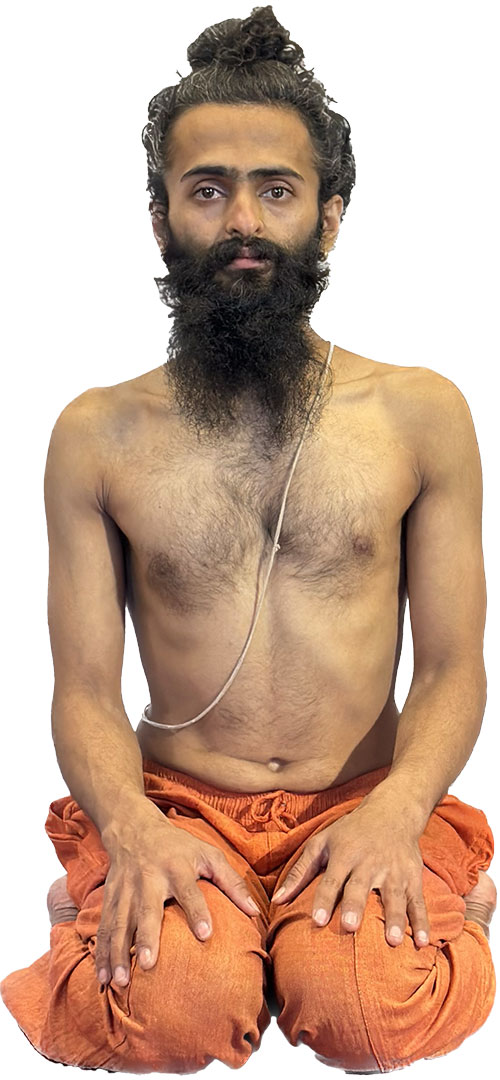
Vajrasana Benefits
- This asana calms the mind reducing stress and stimulating peace and clarity. It further promotes staying healthy and youthful.
- Performing Vajrasana after meals decreases bloating allowing proper digestion and regulating metabolism. It indirectly supports weight loss.
- The overall lower body postures strengthen, align, and improve while sitting in this pose regularly.
Vajrasana Side Effects
- Avoid this pose if one has injuries to the ligaments either at the knees or ankles.
- Those with severe pains of arthritis, intestinal ulcers, and hernia patients should not attempt this pose.
E. Marjari-Bitilasana (Cat-Cow Pose)
Marjari-Bitilasana, or Cat-Cow pose, is an active movement of the spine that flows between two postures. During the marjari pose, the practitioner rounds the back and tucks the chin toward the chest. During the bitilasana pose, the back is arched, and the chest is raised.
Steps for Marjari-Bitilasana
- Set yourself in Bharmanasana (tabletop position), keep the hips directly above the knees and the hands shoulder-width apart.
For Bitilasana (Cow Pose)
- Inhale as you allow the tummy to drop toward the mat, lifting your chest and tailbone.
- Open your chest and bend your back, looking slightly upward.
For Marjari (Cat Pose)
- Exhale as you round your back toward the ceiling.
- Tuck your chin in toward your chest and draw your navel toward your spine.
- Extend the stretch by pressing the mat with your hands and knees.
- Continue with these two postures, consecutively, in sync with your breath.
- Practice 5-10 rounds of the Marjari-Bitilasana pose effortlessly with every inhale and exhale.

Marjari-Bitilasana Benefits
- Marjari-Bitilasana (Cat-Cow Pose) stimulates internal organs for a youthful and energetic body.
- It improves spinal flexibility activating body mobility and strengthening abdominal muscles.
- The back, neck, and shoulder stiffness gets relieved.
- The improvement in digestion increases metabolism helping in weight loss.
- It promotes better breathing sequences.
Marjari-Bitilasana Side Effects
- People may experience lower back or spine irritation if the movements are not done properly.
- The stiffness in the neck or back due to overstretching.
F. Pawanmuktasana (Wind-Relieving Pose)
Pawanmuktasana or Wind Release Pose is a body in a supine position where you bring your knees towards the chest and interlocking hands.
Steps
- Lie down on your back on the mat.
- Lengthen your neck, and shoulders down.
- Gently bend both knees, take toward the chest, and interlock both your hands.
- Interlock both hands on knees, squeeze up the abdomen, and hold both sides of an elbow (if you prefer it).
- Pull the navel inside as you exhale.
- Hold your back up and try taking your chin towards the knee.
- Keep holding for 15-30 seconds with deep breaths.
- Drop your navel down and keep your lower back down.
- Exhale and keep down your upper back.
- Stay as it is for a few breaths.
- Stretch your legs down and relax.
Pawanmuktasana Benefits
- Pawanmuktasana or Wind-Relieving Pose aids digestion promoting deep relaxation and developing a youthful feeling.
- Regular practice stimulates bowel movement, improves digestion, and helps in reducing body weight.
- It stimulates the digestion organs, improves metabolic functions, and strengthens the abdomen.
- The asana eases lower back discomfort and relieves stress.
Pawanmuktasana Side Effects
- Inappropriate posture and alignment strains the back or hips.
- People suffering from knees or back should carefully attempt this pose.
G. Paschimottanasana (Seated Forward Bend)
Paschimottanasana or Seated Forward Bend pose, where practitioners stretch out their legs in a straight position, lengthen the spine, and expand the chest. Then, bend forward to reach feet, ankles, or toes as their flexibility and rise raising hands slowly. The other name for this asana is Intense Dorsal Stretch.
Steps
- Sit on the mat and bring both legs in front of you with pointed toes inward.
- Keep your back straight, lengthen the spine, and expand the chest.
- Inhale and raise both hands, extending the spine further.
- Bring the hands in alignment with the ears.
- Exhale, bring the chin out, and bend down as you can.
- Reach for your feet, ankles, or toes as your flexibility.
- Bring your elbows down on either side of the feet.
- Bring your forehead to rest on your legs.
- Raise your hands slowly in line with your ears.
- Inhale, extend the spine upward.
- Exhale, bring both hands down, and release.
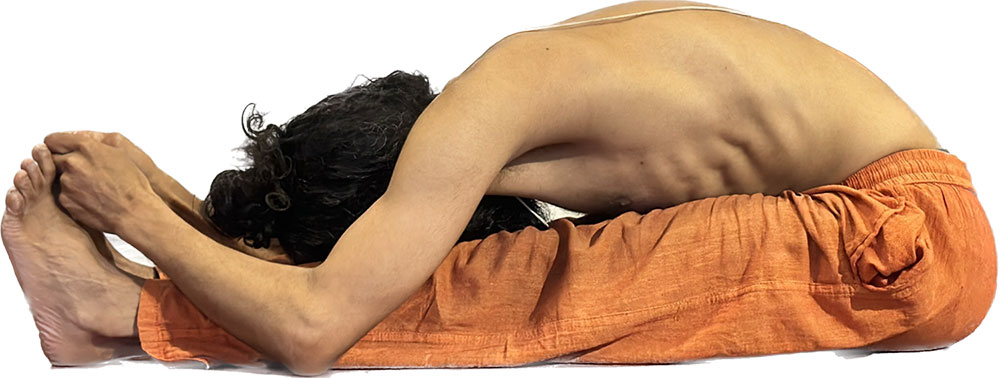
Paschimottanasana Benefits
- Paschimotanasana or Seated Forward Bend pose promotes youthfulness by giving clarity and flexibility to the mind.
- The liver and spleen function properly and strengthen the lumbar and sacral regions.
- One of the ideal poses for people with diabetes.
- It balances metabolism, builds up appetite, and improves digestion for weight loss.
- The flexibility in the body improves due to stretching.
- People get relief from hamstring, calves, neck, and lower back muscle pain as it eases the nervous system.
Paschimottanasana Side Effects
- The inappropriate practice of this pose causes strain on the lower back, shoulders, neck, or hamstrings.
- Be careful while stretching if the practitioner suffers from lower back pain.
Conclusion
The regular and proper practice of these yoga poses enhances flexibility in the body and keeps both mind and body youthful. Improvements in digestion, comfort in the nervous system, and emotional balance bring a positive approach to life, ultimately slowing the ageing process.
Written By: Anjali B
